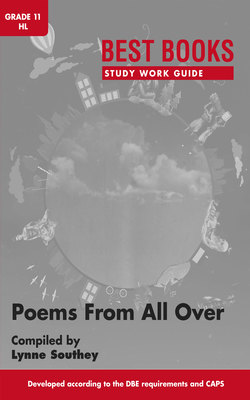Читать книгу Best Books Study Work Guide: Poems From All Over Gr 11 HL - Lynne Southey - Страница 7
На сайте Литреса книга снята с продажи.
Sonnet 130 by William Shakespeare
Оглавление(See p. 3 in Poems From All Over)
| Title: | Shakespeare wrote many sonnets. Some of them are known by their number rather than their title. This one is also known by its first line. |
| Theme: | It is not necessary to use clichés (over-used phrases) to describe one’s beloved. Reality is good enough. |
| Mood: | The poem mocks the elaborate clichés of other poets; the tone is mocking, sarcastic. |
Discussion
This poem is fully discussed on p. xvii of your anthology as an example of how to analyse a poem. The sonnet is a love sonnet, but instead of using the traditional hyperbole (exaggeration) in comparing a beloved with what is most beautiful in nature, Shakespeare describes her as not being those things and tells what he actually sees. He loves the woman as much as any of the other poets love theirs, but refuses to use false comparisons in describing her. He is commenting negatively on other love sonnets (the popular Petrarch sonnets of that period). This sonnet is thus a parody (an imitation of a particular style with deliberate exaggeration for comic effect).
A sonnet has fourteen lines. The Shakespearian sonnet is divided into three quatrains (four lines) and a rhyming couplet. The three quatrains describe the beloved in terms of what she is not (e.g. her cheeks are not red like the roses the poet has seen). The couplet rounds off the sonnet by saying that even though he has not described her as others describe their lovers, he loves her in the same way. In other words the exaggerated comparisons are not necessary to describe real love.
Analysis
| Lines | Comment | |
| 1–4 | The woman’s eyes, lips, breasts and hair are described as not like the sun, not as red as coral, not white as snow and not golden thread. | The descriptions are less romantic but are true. The “nothing” stresses the degree to which the eyes cannot be compared to the sun. Note the repetition of the form “If ... ” (then something else), which stresses what he saying and how it is said. |
| 5–8 | The poet mentions what real roses (the York and Lancaster variety) look like and then says her cheeks are not like that. He mentions perfume and says he receives far more delight from real perfume than from her “reek(ing) breath”. | The poet continues mocking the romantic terms usually used – roses for cheeks, perfume for breath – saying that he cannot describe her in these terms, as other poets might describe their lovers, because he knows roses and perfume and she is not like them. |
| 9–12 | The comparisons continue: her voice is not like music, and the way she moves and walks is not like the way a goddess does. | The two elements being compared here are voice and movement. The poet says he does love her voice, but he knows that music sounds better. Some men describe their lovers as moving like goddesses. Here the poet says he has never seen a goddess moving, which is a humorous poke at others’ comparisons, but his mistress walks normally, on the ground, and doesn’t float above it.Notice how the two statements in this quatrain are both framed with a contrast: not this (like music / floating like a goddess) but that (not as pleasant sounding / walking normally).The quatrains can thus all be said to describe the mistress in ordinary terms as opposed to unrealistic, romantic terms. |
| 13–14 | The poet comes to the point of what he is saying: he loves the woman just as much as other poets love their women even though he doesn’t describe her in false comparisons. | Notice the “And yet” which warns the reader that something different is coming. The “by heaven” is an exclamation that stresses his meaning that his love for her is special and precious. The last line can be interpreted as meaning had she been described in the terms he has not used, her person would have shown them to be untrue. |
Contextual questions
1.Write out the rhyme scheme of the sonnet. (2)
2.What qualities of the sun do you think are used by the other poets to describe a woman’s eyes? (3)
3.Rewrite “than her lips’ red” (line 2) in modern English. (2)
4.If the mistress described in the poem were to read the first twelve lines, how do you think she would feel? Motivate your answer by referring to the poem. (5)
5.Refer to question 4 and your answer. What do you think she would feel if she also read the last two lines? Motivate your answer by referring to the poem. (3)
(15)
| Enrichment activityFind a copy of Shakespeare’s Sonnet 18 “Shall I compare thee to a summer’s day?” and compare it to this poem. Focus on intention and meaning. |
